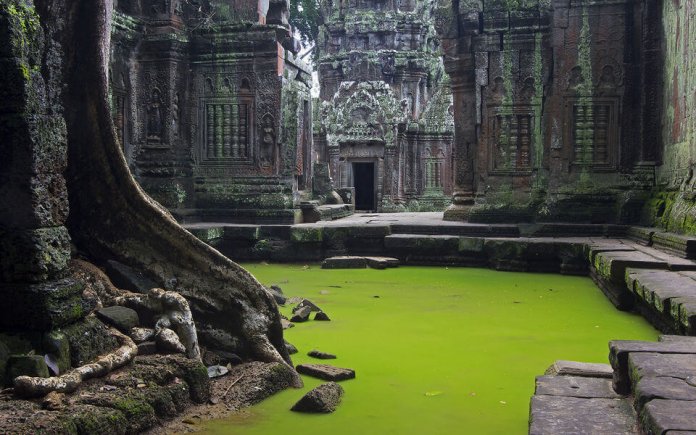In most churches, at first glance, you can recognize their belonging to places of worship. However, there are some churches that surprise and even shock believers with their appearance. We present you the top 7 most unusual churches in the world.
7. Chapel of the Holy Cross
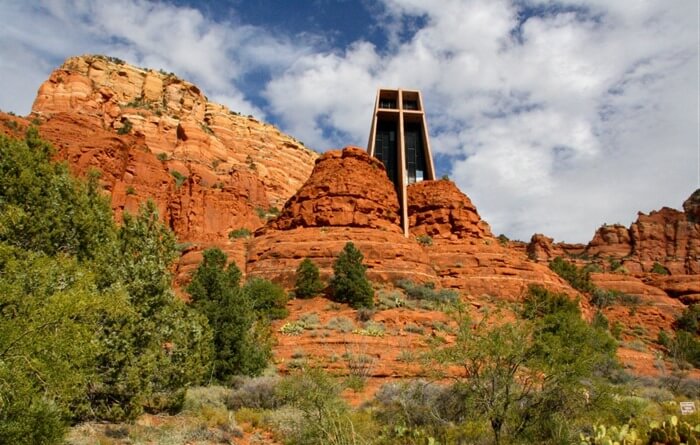 Built on the spectacular red cliffs above Sedona, this outstanding church building is one of the man-made wonders of the American state of Arizona. The chapel, designed by the architect Richard Hein, was built in the 50s of the 20th century at the expense of a zealous Catholic woman, Margarita Staude. The building project was inspired by the Empire State Building.
Built on the spectacular red cliffs above Sedona, this outstanding church building is one of the man-made wonders of the American state of Arizona. The chapel, designed by the architect Richard Hein, was built in the 50s of the 20th century at the expense of a zealous Catholic woman, Margarita Staude. The building project was inspired by the Empire State Building.
According to local believers, the chapel is located in a special, energetically strong place. They believe that the boundaries between the worlds are very thin in the area of construction, and this contributes to spiritual healing. Others say the chapel is just a beautiful place to think about.
6. Ossuary in Sedlec
 This Gothic church, located in the area of the Czech town of Kutná Hora, gives a new perspective on the use of human remains.
This Gothic church, located in the area of the Czech town of Kutná Hora, gives a new perspective on the use of human remains.
The interior of the ossuary, as its name implies, is decorated with human bones and skulls. Legend has it that Abbot Henry returned from the Holy Land in the 13th century and brought with him the soil collected from Calvary. He scattered it around the cemetery. Many people, who learned about this, asked to be buried on the holy ground, but there was not enough room for everyone in the cemetery.
At the beginning of the 15th century, a cathedral with a tomb was built on the territory of the cemetery. And the bones extracted from the graves (to make room for new burials) were stored in the tomb. Over time, their number grew and grew. It wasn't until the 19th century that woodcarver Frantisek Rint began to put things in order in a pile of randomly folded skeletal parts.
Here's what it led to:
- In each corner of the church he piled a bell-shaped pile of bones 3 meters high and 4 meters wide.
- A huge chandelier made of bones and skulls hangs from the ceiling to floor.
- Cups and urns made of bones filled niches in the walls.
- Perhaps the most impressive creation of Master Rint is the coat of arms of the noble Czech Schwarzenberg family, made of bones. It contains an image of a raven that pecks out the eye of a decapitated head.
5. Basilica of St. Ursula
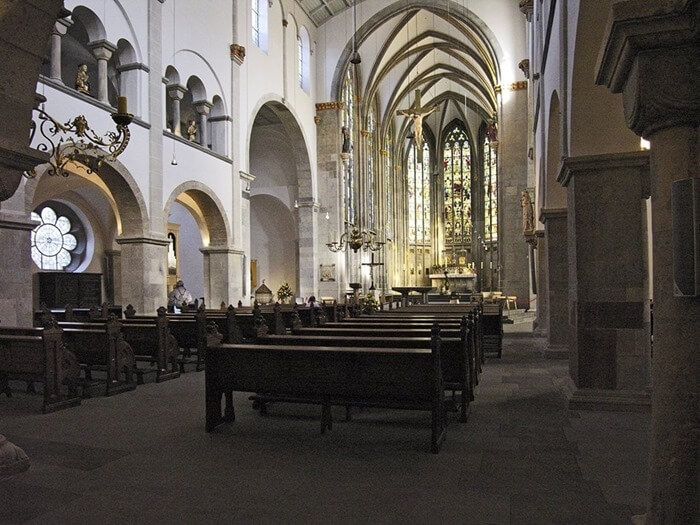 In this basilica you can see the largest mosaic made of parts of human bodies.
In this basilica you can see the largest mosaic made of parts of human bodies.
According to legend, Saint Ursula was a British princess who lived around AD 300-600. As a deeply religious girl, Ursula decided to go on a pilgrimage to Europe. Together with her, 11 thousand virgins went on a trip (according to other versions - only 11, or there were 11 ships, and not girls - you can't make out the years since). Their ships miraculously got from Great Britain to Rome, and then, due to strong winds, headed for Cologne. At this time, the Huns ravaged Europe. Ursula was captured by them and tortured, along with her companions.
Subsequently, the relics of Saint Ursula were placed in the basilica built in Cologne. But in the Middle Ages, a pit full of bones was discovered. It was decided that these were the remains of Ursula's retinue and they were also transferred to the basilica. They now adorn the walls of the Golden Chamber.
Curiously, many of the bones of the "virgins" actually belonged to men, babies, and even large dogs.
4. Cathedral in Maringa
 If the chapel of the Holy Cross is in harmony with the environment, then the cathedral in the Brazilian state of Parana contrasts sharply with the local landscape. This huge conical structure is not only one of the strangest cathedrals in the world, but also the tallest Catholic church in South America, at 124 meters.
If the chapel of the Holy Cross is in harmony with the environment, then the cathedral in the Brazilian state of Parana contrasts sharply with the local landscape. This huge conical structure is not only one of the strangest cathedrals in the world, but also the tallest Catholic church in South America, at 124 meters.
The purpose of such an unusual design of the city temple was to bring people closer to God. Well, a fall from its top will certainly send anyone to meet the Almighty by the shortest path.
Interesting fact: the shape of the cathedral was "suggested" to its architects by Soviet satellites. Don Jaime Luis Coelho was the author of the initial project, and the authorship of the final architectural version belongs to José Augusto Bellucci.
3. Reading between the lines
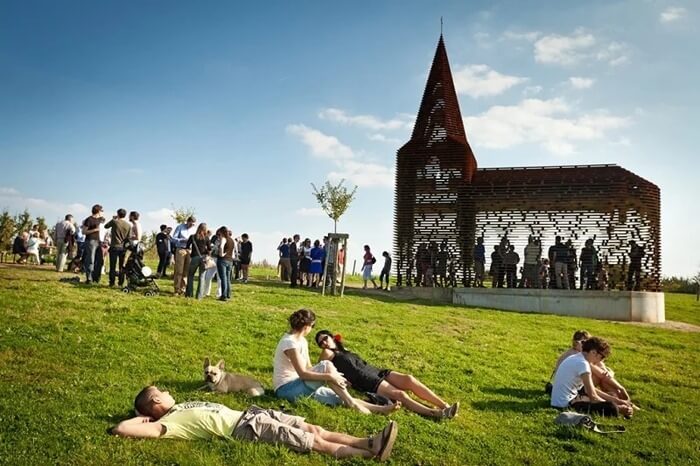 An equally strange church in Borgloon, Belgium has such a strange name.
An equally strange church in Borgloon, Belgium has such a strange name.
To address the dichotomy between the abundance of churches and their seemingly increasing irrelevance in the modern world, architects Peterjan Gijs and Arnout Van Vaerenberg built the unique Reading Between the Lines Church. It is made of 100 layers of steel and allows people to see the landscape on the other side of the church. The cavities between the steel plates give the building an amazing lightness, and if you go inside, you can enjoy the whimsical play of light and shadow.
This building is not used for regular church services, and is, in fact, a work of art. However, any believer has the right to freely enter a "transparent" church and pray.
2. Chen Chapell
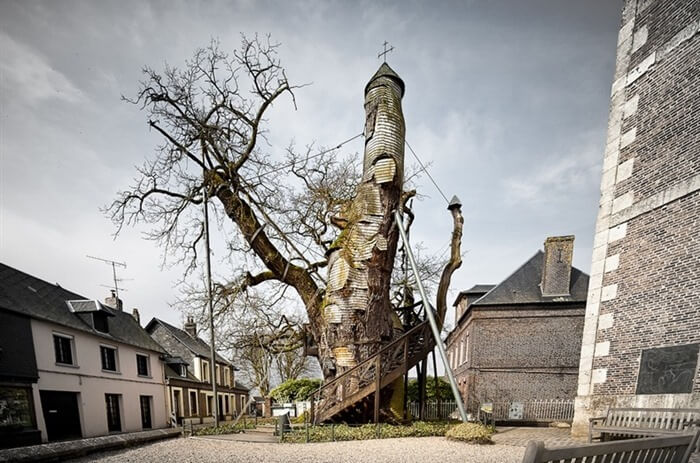 In second place in the ranking of amazing churches is the ancient French church, built inside a giant 800-year-old oak tree. According to local tradition, William the Conqueror himself prayed under this tree.
In second place in the ranking of amazing churches is the ancient French church, built inside a giant 800-year-old oak tree. According to local tradition, William the Conqueror himself prayed under this tree.
In the 17th century, the tree began to be used as a chapel after it was struck by lightning and the wood inside was burned. This event left the oak tree hollow, but still alive. Taking the lightning strike for a divine sign, the local abbot turned the shell of the tree into a chapel.
In the 18th century, atheist revolutionaries threatened to burn the tree, but the locals saved it by renaming it "the temple of the mind" to match the "guidelines" of the French Revolution.
1. Pillar of Katskhi in Georgia
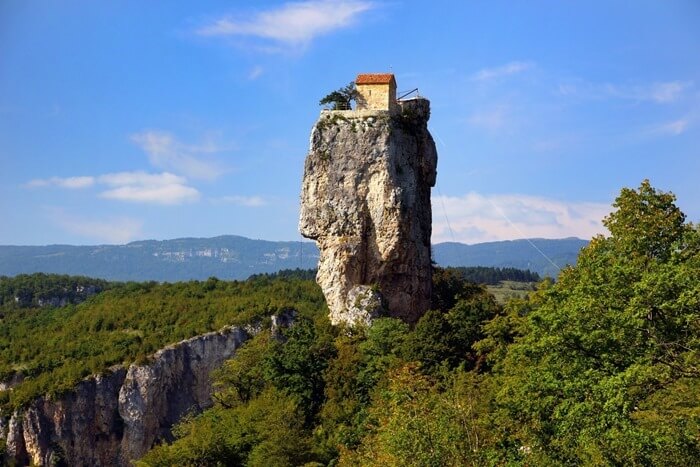 This is probably the most unusual church on Earth, and one of the places closest to the "heavenly office". After all, the church was erected on a large limestone monolith, the height of which is 40 meters.
This is probably the most unusual church on Earth, and one of the places closest to the "heavenly office". After all, the church was erected on a large limestone monolith, the height of which is 40 meters.
At one time, pagans used this monolith to worship the god of fertility, but this stopped when Georgia converted to Christianity.
Around the seventh century, a small church was built on top of the pillar. She was the visible embodiment of escape from the vanity of life and closeness to God. The monks used it for religious rituals until the Ottoman Turkey invaded Georgia.
In the 18th century, attempts were made to climb the Katskhi pillar, but they all ended in failure, and he submitted to Soviet researchers only in 1944.
The study of the upper part of the column showed that there were once cells, a crypt, and there was also a wine cellar, that is, monastic life was not devoid of all earthly pleasures.
In 1993, a lonely monk, Father Maxim, moved to the grotto under a stone column and lived there all winter. He collected donations for the construction of the temple, and achieved his goal - the construction began in 2008, and was carried out with the support of the townspeople and the clergy.
Currently, in the southeast of the Katskhi pillar, there is a temple named after Maxim the Confessor. Local residents gave the building another name - "Fortress of Solitude".

